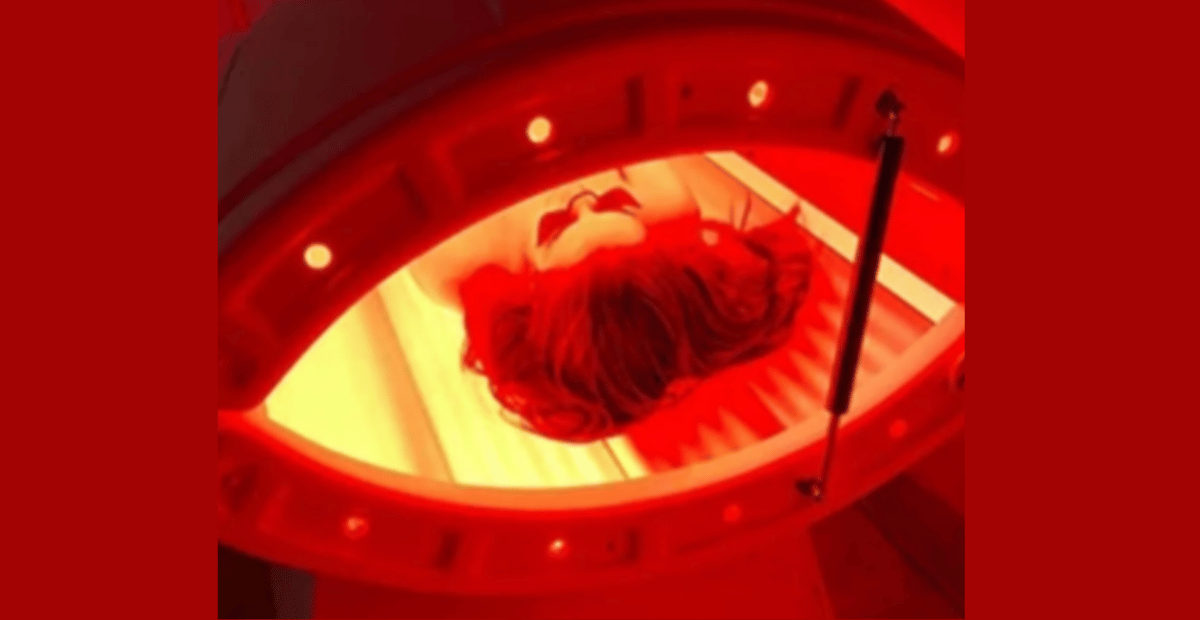Red light therapy for eczema is emerging as a promising, non-invasive treatment that may help soothe inflammation, reduce itching, and accelerate skin healing. As flare-ups become increasingly difficult to manage with conventional methods, many people are turning to red light therapy for a more natural and gentle solution.
This article will discuss how red light therapy works, the science behind its effects on eczema-prone skin, what devices are most effective, and how to use them safely at home. Whether you're newly diagnosed or have been battling eczema for years, you'll find insights that could change how you approach flare-ups. Keep reading to explore the full potential of red light therapy for long-term eczema relief.
What Is Red Light Therapy?
Red light therapy is a non-invasive treatment that uses specific wavelengths of red and near-infrared light, usually between 630 and 850 nanometers, to support healing and reduce inflammation. These wavelengths penetrate the skin safely, working at the cellular level to encourage regeneration and tissue repair.
Originally used for wound healing, red light therapy is now widely applied in skincare, pain relief, and muscle recovery. It’s also gaining recognition for treating chronic skin conditions like eczema. Unlike UV light, it doesn’t damage the skin; instead, it stimulates cellular energy (ATP), helping the skin recover and strengthen over time. That’s why red light therapy for eczema is becoming a go-to option for natural relief.
Understanding Eczema: What It Is and What Causes It

Eczema, or atopic dermatitis, is a chronic skin condition marked by inflammation, redness, itching, and dryness. It can appear anywhere on the body, but is most common on the face, hands, elbows, and knees. While it’s not contagious, eczema can be incredibly disruptive to daily life, especially during flare-ups.
Common Causes and Triggers:
-
Genetics: If eczema runs in your family, you’re more likely to develop it.
-
Weakened Skin Barrier: People with eczema often have skin that struggles to retain moisture and repel irritants.
-
Immune System Dysfunction: An overactive immune response can lead to chronic inflammation in the skin.
-
Environmental Factors: Dust mites, pollen, pet dander, and harsh soaps can trigger flare-ups.
-
Diet and Stress: Certain foods (like dairy or gluten) and emotional stress can worsen symptoms for some individuals.
There’s no single cause, and no universal cure, but managing triggers, repairing the skin barrier, and reducing inflammation are all key. That’s why many people are now exploring red light therapy for eczema as part of their holistic skin care routine.
How Red Light Therapy Targets Eczema Symptoms
Eczema, also known as atopic dermatitis, is driven by immune dysfunction, skin barrier damage, and chronic inflammation. Red light therapy for eczema is effective because it directly addresses many of these underlying issues.
Here’s how it works:
-
Reduces Inflammation: Light wavelengths calm the inflammatory response in the skin, easing redness, swelling, and irritation.
-
Strengthens the Skin Barrier: Stimulates collagen production and improves skin cell turnover, aiding recovery.
-
Soothes Itchiness: By promoting cellular repair, it reduces the triggers that cause itching.
-
Balances Immune Activity: It modulates cytokine levels, decreasing flare-up frequency and severity.
Patients often report softer skin, fewer rashes, and a significant drop in itch intensity after a few weeks of consistent use.
How to Use Red Light Therapy for Eczema
Consistency and proper technique are essential for getting the most out of red light therapy for eczema. Whether you’re using a handheld wand, panel, or bed, here’s how to do it right:
Step-by-Step Guide:
-
Choose the right wavelength: Look for devices with 630–660 nm for surface skin healing and 810–850 nm for deeper tissue repair.
-
Clean the skin: Make sure the eczema-affected area is clean and dry.
-
Position the device: Hold or place the device 6–12 inches from your skin.
-
Start slow: Begin with 5–10 minute sessions 3–5 times per week, then increase based on tolerance and product recommendations.
-
Track progress: Take weekly photos to monitor improvements and adjust usage as needed.
Safety Tips:
-
Avoid using on open wounds or infected skin.
-
Always follow the manufacturer’s guidelines.
-
Consult your dermatologist before starting, especially for children or severe cases.
Featured Red Light Therapy Devices for Eczema Relief
If you're ready to try red light therapy for eczema, choosing a trusted device is key. Here are standout options from Airvida’s red light therapy collection designed for both home and clinic use:
1. Airvida Aura Red Light Therapy Bed

The Aura Bed delivers broad-spectrum red and near-infrared light therapy designed for whole-body use. It’s especially effective for those experiencing widespread eczema, targeting both inflammation and skin barrier dysfunction simultaneously. Its user-friendly design and optimized light penetration make it a great choice for daily sessions, promoting faster recovery without discomfort. With multiple treatment modes and energy-efficient output, the Aura strikes a balance between clinical-grade performance and at-home accessibility.
2. Airvida Radiance Red Light Therapy Bed

The Radiance Bed offers increased light intensity and surface coverage, making it ideal for individuals with moderate to severe eczema or stubborn, recurring flare-ups. Its enhanced output allows for deeper tissue stimulation and longer-lasting anti-inflammatory effects. This model is often favored by wellness clinics and advanced home users who need maximum light exposure across large treatment areas. It’s a premium choice for those seeking consistent, high-powered relief.
3. Dr. Mueller Red Light + Vibration Plate

This innovative device combines red light therapy with low-frequency vibration to encourage circulation, lymphatic drainage, and cellular regeneration, all crucial in addressing eczema from a systemic level. While the red light targets inflammation and skin damage, the vibration plate supports detoxification and nutrient delivery. It's especially useful for individuals who experience inflammation tied to poor circulation or toxin buildup, and it serves as a powerful complement to a holistic eczema treatment plan.
Benefits and Limitations to Keep in Mind
Like any treatment, red light therapy for eczema has its advantages and drawbacks. Understanding both can help set realistic expectations and support more effective use.
Benefits
One of the biggest advantages of red light therapy is that it's completely non-invasive and painless. Most users experience no discomfort during sessions, and when used properly, there are no known side effects. It’s also suitable for all skin types, making it accessible to a wide range of individuals. For many, it helps reduce dependence on topical steroids or oral antihistamines by supporting the skin’s natural ability to heal and calm inflammation.
Limitations
While promising, red light therapy isn’t a quick fix. Visible results may take two to six weeks of consistent use, and it’s not a standalone cure for eczema. Rather, it works best when combined with other healthy habits like proper moisturizing, diet adjustments, and stress management. Additionally, medical-grade or high-performance red light devices can be a significant upfront investment, especially for those seeking full-body coverage at home.
Final Thoughts: Is Red Light Therapy for Eczema Worth It?
With its ability to reduce inflammation, speed healing, and restore skin integrity, red light therapy is a powerful tool in the fight against chronic flare-ups. While it's not a magic bullet, it offers significant promise, especially for those seeking more natural, long-term solutions.
Red light therapy for eczema is gaining recognition as a supportive, non-invasive option for those struggling with chronic itching and irritation. Before starting any new therapy, it’s always best to consult your healthcare provider to ensure it fits your overall treatment plan.
Frequently Asked Questions on Red Light Therapy for Eczema
Is red light therapy ok for eczema?
Yes, red light therapy is generally safe for eczema and may help reduce inflammation, itching, and skin irritation.
How long should a red light be for eczema?
Most sessions last 10–20 minutes per area, done 3–5 times per week, depending on the device and severity.
What type of light is good for eczema?
Red light (630–660 nm) and near-infrared light (810–850 nm) are both effective for reducing inflammation and promoting skin healing.
How to use light therapy for eczema?
Clean the skin, position the device 6–12 inches away, and expose the area for the recommended time. Repeat consistently for best results.
Can too much red light be harmful?
Overuse can lead to mild skin irritation or temporary redness, but red light therapy is safe when used as directed.
You May Also Want to Read:
Ultimate Guide to Red Light Therapy for Hair Growth 2025
5 Factors That Set Professional Red Light Therapy Devices Apart From Other Machines
Best Red Light Therapy Devices Explained: Features, Wavelengths, and Benefits
Disclaimer
Airvida and partners' advice does not constitute medical advice and is intended for informative and educational purposes only, with no medical or non-medical claims being made. While research & studies show the potential Hyperbaric Oxygen Therapy (HBOT) and Hyperbaric Air Therapy (HBAT) may have implied benefits, individual results may vary. It is required by Airvida & Partners to consult with doctors before being approved for Hyperbaric Therapy (HBOT & HBAT). Read More HERE




